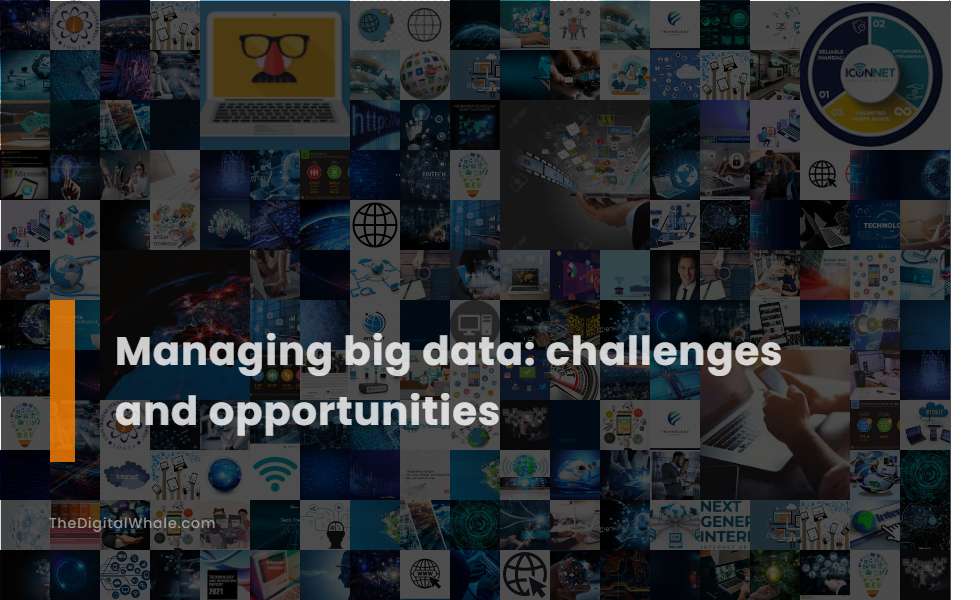Managing Big Data: Challenges and Opportunities
What are the seven challenges faced by service providers working with Big Data? What are the challenges in big data management? Let's find out more about Managing Big Data: Challenges and Opportunities.

Data Volume and Storage: Managing and storing massive data sets.
Managing massive data sets involves utilizing scalable and fault-tolerant storage solutions such as distributed file systems like Hadoop Distributed File System (HDFS), NoSQL databases like MongoDB and Cassandra, and cloud-based storage options like Amazon S3, Google Cloud Storage, and Microsoft Azure Blob Storage. These solutions enable efficient data storage, parallel processing, and cost-effective scalability to handle the volume, velocity, and variety of big data. For more insights, explore the Big Data Storage Solutions that cater to the diverse needs of modern enterprises.
Data Variety and Integration: Handling and combining different data types from diverse sources.
Managing Big Data involves significant challenges in integrating and handling data variety, including merging structured, unstructured, and semi-structured data from diverse sources, ensuring consistency and quality. It is crucial to employ robust Data Integration Platforms and data wrangling tools to automate cleaning and transformation, thereby streamlining the process and improving the efficiency of data management strategies.
Data Velocity and Real-Time Processing: Processing data in real-time to support swift decision-making.
Managing Big Data's high velocity and real-time processing involves coping with the staggering influx of data streams, minimizing latency, and ensuring data quality and accuracy. Solutions include implementing distributed processing frameworks like Apache Kafka or Spark Streaming, utilizing in-memory computing and caching mechanisms, and employing data validation checks to handle the volume, velocity, and complexity of real-time data streams. For more detailed solutions, visit the insights provided by Trigyn.
Data Veracity and Quality Control: Ensuring data quality and accuracy to prevent inaccurate analyses.
Ensuring data veracity in big data involves addressing issues of accuracy, quality, and trustworthiness by implementing robust data governance practices, validating data sources, and using advanced analytics to detect inconsistencies, thereby preventing inaccurate analyses and ensuring reliable decision-making. In addition, measuring and maintaining data accuracy requires defining ideal data states, validating against trusted sources, calculating error rates, and implementing automated validation checks, feedback mechanisms, and regular data audits. For detailed guidance on enhancing data accuracy and ensuring the reliability and trustworthiness of your data, you can explore this comprehensive Data Accuracy Guide. By adhering to these strategies, organizations can ensure accurate analyses and decision-making processes.
Data Security and Privacy: Protecting sensitive information and complying with regulatory requirements.
Protecting Big Data involves addressing complex security and privacy challenges, including ensuring compliance with regulations like GDPR and HIPAA, implementing robust access controls, encrypting data at rest and in transit, and using advanced anonymization techniques to safeguard personal and sensitive information. For more detailed insights, visit the RedZone Technologies blog on Big Data Security to explore how these measures can be effectively implemented.
Related:
What are the main benefits of artificial intelligence for businesses? What are the effects of artificial intelligence on businesses? Let's find out more about Artificial Intelligence and Its Implications for Business.
Skill Shortage and Resource Constraints: Addressing the lack of skilled personnel and managing high infrastructure costs.
Managing Big Data is hindered by a significant skill gap, with a need for professionals skilled in big data technologies, and resource constraints, particularly for small and medium-sized businesses that find the associated costs prohibitive. To address this, organizations can partner with software development services, invest in training existing staff, and leverage cloud-based solutions to manage infrastructure costs efficiently. For more insights into these challenges and potential solutions, explore the detailed article on Data Science Central.
Informed Decision-Making: Using big data analytics to base decisions on data for more precise and effective strategies.
Big Data Analytics enables informed decision-making by providing deep insights into market trends, consumer preferences, and operational efficiencies. This allows businesses to anticipate market shifts, optimize operations, and personalize customer experiences, thereby driving more precise and effective strategies. For more information on the impact of big data, visit the London SBA Blog.
Enhanced Customer Understanding: Delving deep into customer preferences and behaviors for personalized marketing and improved satisfaction.
Big Data enhances customer understanding by analyzing large datasets to identify trends, segment target audiences, and tailor marketing campaigns, resulting in more personalized and targeted messaging that improves customer satisfaction and conversion rates. This approach allows businesses to gain a deeper insight into customer preferences, behaviors, and buying patterns, enabling the creation of highly customized content and interactions. For more detailed insights, visit the Institute of Data website.
Operational Optimization: Using big data for cost reduction, increased productivity, and resource allocation through predictive maintenance and supply chain enhancement.
Big Data Analytics enhances operational efficiency by identifying areas of inefficiency, predicting maintenance needs, and optimizing resource allocation, leading to cost reduction, higher productivity, and improved service delivery. Through predictive maintenance and supply chain optimization, businesses can achieve significant improvements in their operational processes. For more insights on how these strategies can transform your business, visit the comprehensive guide on Integrating Big Data Analytics into Business Operations.
Competitive Edge and Innovation: Identifying trends and opportunities ahead of competitors and fostering the creation of new products and services.
Big Data Analytics provides a competitive edge by enabling organizations to identify trends and opportunities ahead of competitors, and it fosters the creation of new products and services by analyzing vast amounts of data to cater to evolving customer needs and preferences. For more insights into how industries are being transformed, visit the CRG Solutions website.
Related:
What are some of the benefits of using the Internet of Things within businesses? What are some of the key benefits of the internet of things in business? Let's find out more about The Internet of Things and Its Impact On Businesses and Consumers.
